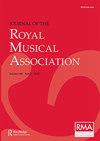马尔科姆-阿诺德第五交响曲第一乐章中的西伯利亚形式原则
IF 0.5
2区 艺术学
0 MUSIC
引用次数: 0
摘要
马尔科姆-阿诺德的交响曲因其与传统体裁预期之间的关系问题而一直存在分歧。尤其是那些摒弃了奏鸣曲式的调性冲突和形式标记,转而采用主题和音色驱动过程的作品。在这些方面,西贝柳斯,而不是德奥交响乐传统的成员,是阿诺德交响乐创作的重要典范。本文将詹姆斯-赫波科斯基(James Hepokoski)明确指出的西贝柳斯后期交响乐风格的四项形式原则(基于内容的形式、目的论的起源、旋转形式和克朗冥想)应用于阿诺德第五交响曲的第一乐章--这是他最令人钦佩但又最不拘一格的交响曲结构之一。分析结果表明,该乐章复杂而平易近人,具有独特的张力和戏剧趣味。它绝非交响乐轻量级作品的乏善可陈,而是二十世纪末该体裁令人印象深刻的标志性作品。本文章由计算机程序翻译,如有差异,请以英文原文为准。
Sibelian Formal Principles in the First Movement of Malcolm Arnold’s Fifth Symphony
Malcolm Arnold’s symphonies have persistently divided critical opinion because of their problematic relationship with traditional genre expectations. This is especially the case in works that eschew sonata-style tonal conflicts and formal markers in favour of theme- and timbre-driven processes. In these respects, Sibelius, rather than members of the Austro-German symphonic tradition, was an important model for Arnold’s individual approach to symphonic composition. This article applies four formal principles (content-based forms, teleological genesis, rotational form and klang meditation), which James Hepokoski has explicitly identified with Sibelius’s later symphonic style, to the first movement of Arnold’s Fifth – one of his most admired and yet most unconventional symphonic structures. The resulting analysis shows a complex and yet accessible movement that generates its own unique tension and dramatic interest. Far from being the feeble work of a symphonic lightweight, it is an impressively realized landmark of the genre in the late twentieth century.
求助全文
通过发布文献求助,成功后即可免费获取论文全文。
去求助
来源期刊
CiteScore
0.50
自引率
0.00%
发文量
16
期刊介绍:
The Journal of the Royal Musical Association was established in 1986 (replacing the Association"s Proceedings) and is now one of the major international refereed journals in its field. Its editorial policy is to publish outstanding articles in fields ranging from historical and critical musicology to theory and analysis, ethnomusicology, and popular music studies. The journal works to disseminate knowledge across the discipline and communicate specialist perspectives to a broad readership, while maintaining the highest scholarly standards.

 求助内容:
求助内容: 应助结果提醒方式:
应助结果提醒方式:


